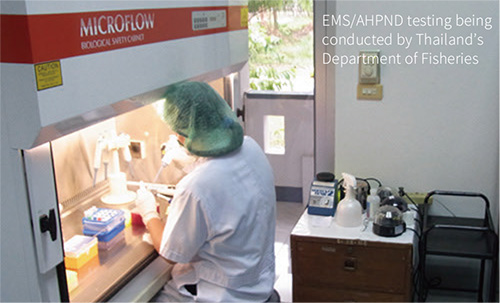Research Results
Aiming to advance aquaculture with cutting-edge science and technology
Next-generation aquaculture technology created in Thailand FY2018

- Nobuaki Okamoto (Chief Director of Tokiwamatsu School Group)
- SATREPS
- Bio-resources: "Development of Aquaculture Technology for Food Security and Food Safety in the Next Generation" Research Representative (2011-2016)
Issues facing the expanding aquaculture industry
The global demand for marine products has increased rapidly in recent years. It is predicted that demand in 2030 will be roughly twice that seen in 2007, and this has the potential to lead to overexploitation of natural fish stocks. Another reason for increased interest in aquaculture is that catches of natural fish stocks fluctuate in volume considerably over time. More than half of the world' s edible marine products are already produced through aquaculture, and this proportion is expected to continue increasing.
While demand is increasing on the one hand, aquaculture facilities face a wide variety of issues including implementing disease countermeasures, ensuring safety, and establishing market value. Each of the issues are mutually interlinked—putting in place disease countermeasures, for example, helps to secure safety and this is reflected in market value—and it is important therefore that each issue is considered in a holistic manner. Given these circumstances, President, Dr. Nobuaki Okamoto of Tokyo University of Marine Science and Technology (current chief director of Tokiwamatsu School Group) and his team of researchers are working together with Thai researchers on the "Development of Aquaculture Technology for Food Security and Food Safety in the Next Generation" through JST' s Science and Technology Research Partnership for Sustainable Development (SATREPS) program.
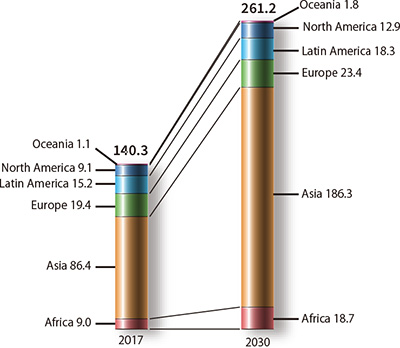
Forecast of fisheries demand (Unit: million t) Source: US Treasury Statistics
Global demand for maritime products is expected to almost double by 2030
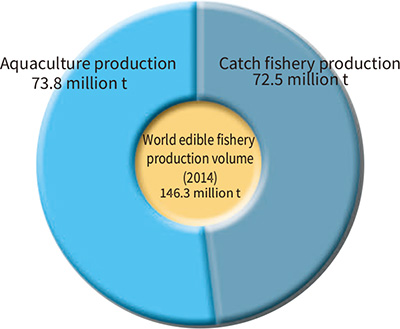
Source: United Nations Food and Agriculture Organization (FAO) Document
More than half of the maritime products that grace our tables are produced through aquaculture
Researching aquaculture issues in a comprehensive manner
First of all, Dr. Okamoto and his team identified the issues currently faced by aquaculture facilities and, based on their findings, set five areas of focus for their research: "Molecular breeding", based on selecting individuals with favorable characteristics; "Surrogacy", involving reproducing the eggs of high-grade fish in other more robust species that mature more rapidly; "Disease prevention" through vaccine development etc.; "Alternative feed" to reduce the amount of fish meal used to feed aquaculture fish; and "Risk factor detection" aimed at ensuring food safety. Through working on these areas of focus the researchers plan to contribute to increased production of aquaculture products that are evaluated highly in the marketplace. The fish covered in their research were narrowed down to groupers, sea bass, and tiger prawns—all maritime produce with high market value.
As part of their research into "Molecular breeding" the researchers became the first in the world to create a genetic linkage map of grouper genes. Based on this map they are developing* DNAmarkers (markers of the genetic characteristics of individuals) relating to outstanding growth potential as well as genetic markers relating to disease resistance in black tiger prawns. Utilizing these DNAmarkers in molecular breeding is expected to make it possible to select individuals for aquaculture based on their growth potential and resistance to disease. *Patents pending
As part of their work on surrogate broodstock the researchers conducted research into transplanting the germline cells of giant groupers (a high-grade fish that takes seven to eight years to mature) into tiger troupers (which only take two years to mature). Folowing basic research using rainbow trout, which are ralatively easy to manage.
Thailand's Department of isheries is rearing tiger groupers with giant grouper germline cells transplanted into them. If this surrogacy technology can be successfully established, it will be possible to reduce the size of parent fish, reduce the time required for them to mature, and select useful characteristics in an efficient manner. reezing germline cells will also lead to preservation of genetic resources.
As part of their research into disease prevention the researchers succeeded in developing a vaccine for streptococcal infections and have begun working on commercializing it. They also identified the malachite green problem as one of the issues requiring attention as part of their research into risk factor detection. Malachite green was widely used in the past as an antimicrobial agent in aquaculture but following reports that it was carcinogenic its use was prohibited. ontamination from residual malachite green in soil continues to be a matter of concern however. As part of their research, the researchers established a method of rapidly detecting residual malachite green. They are also searching for microorganisms that are able to break down malachite green as a way to lower the risk of recontamination. As part of their research into alternative feed they have worked on developing animal protein feed that can provide an alternative to fish meal and have begun promoting to aquaculture business operators a feed they have developed that is free of fish meal.
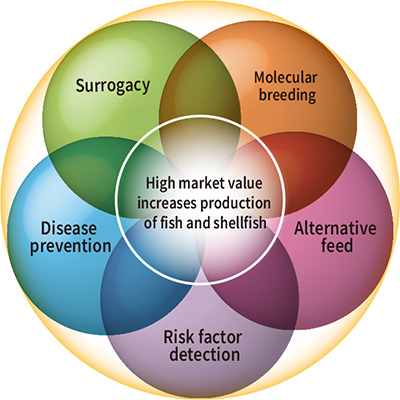
5 research themes
Responding flexibly to emergencies affecting aquaculture facilities
There is an incident that deserves special mention in connection with infection prevention. In early 20 3, two years after the research project was launched, an infectious disease suddenly appeared in a prawn (white-legged shrimp) aquaculture pond in Thailand. This disease, which was later named EMS/ AHPND, caused necrosis of the hepatopancreas, and had close to a 00% mortality rate for any young shrimp that were infected with it. The production output of white-legged shrimp in Thailand the following year dropped to less than half that of ordinary years. As EMS/AHPND was also confirmed in Malaysia, Vietnam, hina, and Mexico, the researchers decided to immediately begin researching the disease in light of the severity and urgency of situation, despite it not being included in the original research plan.
In July 20 3, Dr. Donald Lightner and his colleagues at the University of Arizona in the United States reported that the disease was caused by the bacteria vibrio parahaemolyticus. However an apathogenic strain of vibrio parahaemolyticus can also be found at aquaculture facilities. Therefore, there was a need to develop a diagnostic method to distinguish between pathogenic and apathogenic strains. In June 20 4 the research team identified two toxin genes unique to the pathogenic strain and developed a diagnostic method targeting this.
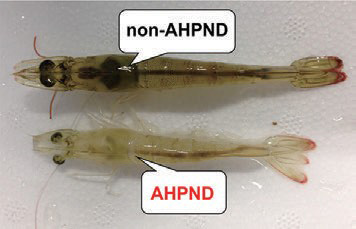
A healthy prawn (top) and a prawn infected with EMS/AHPND (bottom). The speech bubble indicates the position of the hepatopancreas, which turns white following necrosis.
Popularizing the standard diagnosis method in Asia and the rest of the world
The EMS/AHPND diagnosis method that was established as part of the research project was capable of diagnosing infection with a 100% accuracy rate. The government of Thailand immediately adopted it as a standard diagnosis method and worked on spreading its use amongst prawn aquaculture business operators in Thailand. As a result, aquaculture business operators—who had been at a loss as to what to do—managed to come back from the brink, and Thailand's prawn production output was able to recover. The World Organisation for Animal Health (01E) also adopted it as a standard diagnosis method and is working to spread its use to prawn aquaculture facilities throughout Southeast Asia and the rest of the world. The diagnosis method is also likely to aid the development of new technologies to curb the spread of the disease by enabling the removal of pathogenic vibrio parahaemolyticus from the seawater used in aquaculture.
